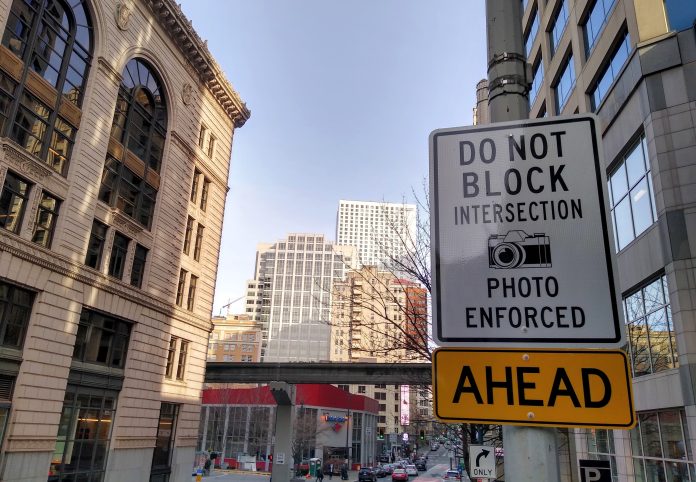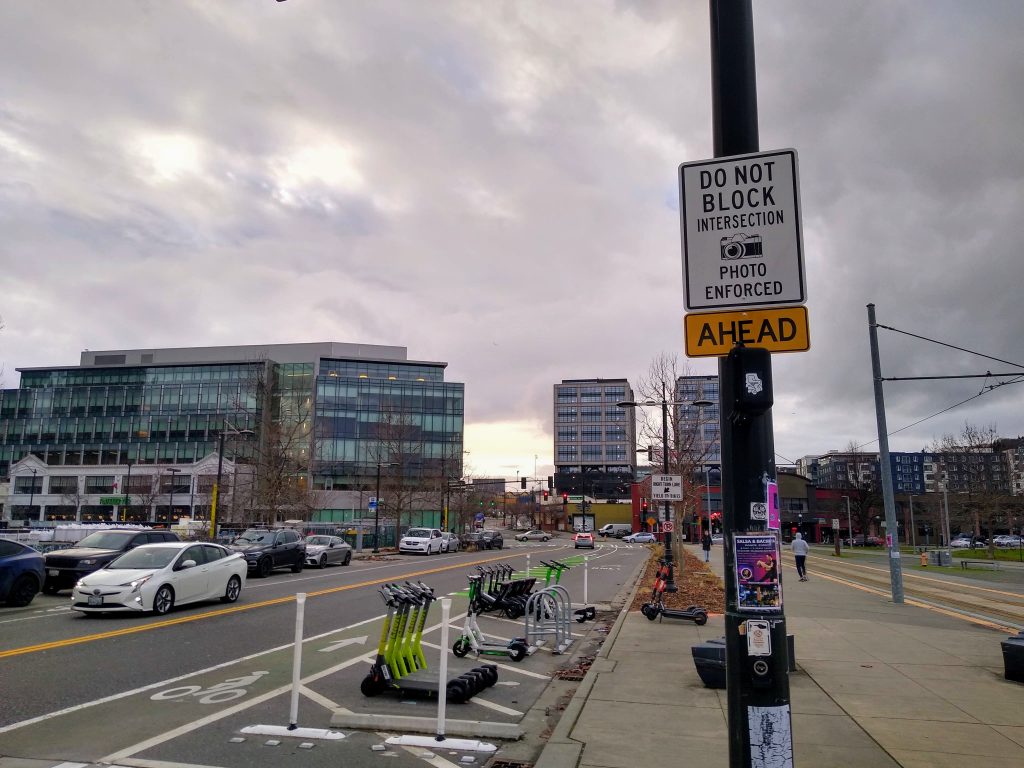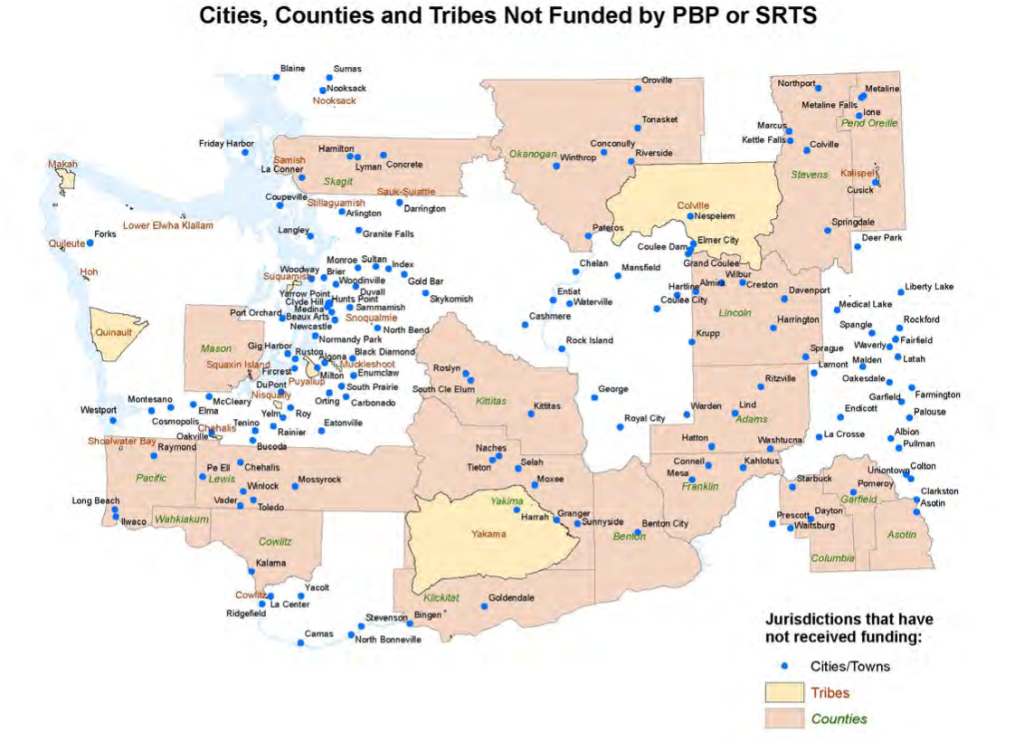
For the entirety of 2021, the City of Seattle issued citations to drivers using the West Seattle low bridge during the hours of the day when traffic is restricted to transit, freight, emergency vehicles, and a small number of other authorized users. Those tickets, $75 after an initial warning-only, were able to be issued via automatic camera thanks to a Seattle-specific pilot program that was authorized by the state legislature in 2020. Under the terms of that pilot, after overhead costs, half of the proceeds from citations issued under that authorization do not stay in the City of Seattle but are earmarked for a new account that has been created for “bicycle, pedestrian, and nonmotorist safety improvements” administered by the Washington Traffic Safety Commission.
Until now, it has not been clear what those dollars would actually be used for. The Cooper Jones Active Transportation Safety Council, a subcommitee of the Traffic Safety Commission, has been discussing how to utilize the funds, which are being deposited in an account named after that committee. That council, made up of public employees and members of transportation advocacy organizations from around the state, doesn’t actually meet in public and isn’t technically a decision-making body, or so the traffic safety commission argues, so it will be the broader commission actually approving the use of the funds.
The traffic safety commission does issue grants around pedestrian and bicyclist safety. But according to meeting minutes from late 2021, commission staff concluded that the funding that is coming, which includes $400,000 in Governor Jay Inslee’s proposed 2022 budget, wouldn’t be enough to impact more than a few small projects. A proposal to utilize the funding to instead better enable communities across the state to apply for bicycle and pedestrian safety grants, as well as safe routes to school grants, that the Washington State Department of Transportation (WSDOT) awards was developed instead. Unlike the Traffic Safety Commission’s grants, which are heavily geared toward police enforcement and education efforts, the WSDOT grants fund physical changes to streets around the state that improve access and safety for people who are walking, rolling, and biking.

WSDOT’s 2021 report on those safety grants noted that jurisdictions around the state are either unaware of the funding available from these programs, or lack knowledge of best practices around submitting an application. This puts them at a disadvantage compared to cities with more staff able to work on grant applications. “With new funded staff, WSDOT could assist overburdened jurisdictions with design and treatment selection, cost estimates, and scheduling. This assistance should increase applications from jurisdictions that have not participated in the past, and enable jurisdictions to submit higher quality applications that have a greater chance of being funded,” the report noted.
Barb Chamberlain, Director of the Active Transportation division at WSDOT, noted that the department has not yet decided exactly the best way to add that additional capacity. “We have in mind a variety of activities that fit into capacity-building and build on the findings and recommendations in the Active Transportation Plan. We haven’t yet costed out which elements might be things we could do in-house (particularly if we are able to add staff, which will depend on legislative budget action) and which we might do by contracting out.”
Chamberlain provided addditional examples of what this capacity-building work might entail: preparing an equity analysis to add context to the crash analysis currently completed, developing training on how high-quality projects are developed, and supporting communities in developing active transportation plans of their own. Funding could also just be used to help get the word out to more people and places.
But Chamberlain noted that the overall level of funding available for the grants, which is set by the legislature and wouldn’t change with this proposal, is the biggest hurdle that cities and towns cite. “The #1 constraint is knowing how competitive the programs are because we get so many applications; basically they won’t invest the time when they know the odds are so challenging,” she said, noting that only roughly one out of every five applications is successful. “The solution to that rests with the legislature as they set funding levels.”
Four hundred and seventy-eight projects have received funding across the two programs since 2005, totaling $251 million in improvements. But 1,394 have gone unfunded.

According to WSDOT, since 2005, only 45%, or 121, of the 281 incorporated cities and towns in Washington have received funding through the programs. Meanwhile, 20 counties in the state have not received a single grant nor have eight out of the 29 federally-recognized tribes in the state.

Last year, Governor Inslee proposed adding a total of $20 million to the bicycle/pedestrian and safe route to school grants program. By the time the legislature finalized its budget, that amount had been cut in half. This year, the Governor has proposed a $45 million increase ($30 million for bicycle and pedestrian grants, $15 million for safe routes to schools) but those funds are set to come from revenue generated by the Climate Commitment Act, which isn’t set to come in until 2023. That program is set to generate over $700 million per biennium for transportation decarbonization when it’s fully operational, but it remains to be seen whether these grant programs will ever receive enough appropriations to get close to meeting the scale of the requests.
On the City of Seattle side, the Seattle Department of Transportation is current forecasting to recieve $1.4 million in 2022, which it is investing in installing Acccessible Pedestrian Signals (APS) across the city, in accordance with the requirement that the city spend the camera revenue on improvements that “support equitable access and mobility for persons with disabilities.” The state is being more conservative in its estimates on how much revenue will be generated, which is understandable given its proposed use at the state level.
State Senators Rebecca Saldaña and Jamie Pedersen have introduced a bill that would extend the expiration date for the Seattle-only camera enforcement pilot from mid-2023 to mid-2025. Senate Bill 5707 has a hearing this Tuesday, January 18th in the Senate transportation committee at 4:00pm. There are a number of other bills that have been introduced this session to expand automatic traffic camera authority, including Senate Bill 5687, which would allow school zone speed cameras to be added where kids walk and bike to get to school and not just at the school’s front door. But the new bills don’t prescribe where the additional revenue that would be generated should go; that extra step is reserved for a bill that only impacts the City of Seattle.
Because the Seattle pilot includes types of enforcement cameras that aren’t authorized anywhere else in the state, there remains a contingent of the Democratic caucus in the state legislature opposed to keeping the authorization in place. But as Seattle tries to lead the state away from a traffic safety culture still heavily focused on police enforcement, it’s clear that automatic enforcement will remain a vital tool. And for now, Seattle’s automatic cameras are set to help jurisdictions all around Washington be better positioned to move in the right direction as well.
Ryan Packer has been writing for The Urbanist since 2015, and currently reports full-time as Contributing Editor. Their beats are transportation, land use, public space, traffic safety, and obscure community meetings. Packer has also reported for other regional outlets including BikePortland, Seattle Met, and PubliCola. They live in the Capitol Hill neighborhood of Seattle.

